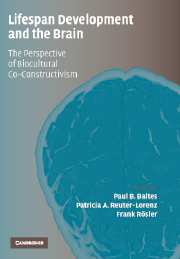52 results
Resilience and levels of reserve capacity in later adulthood: Perspectives from life-span theory
-
- Journal:
- Development and Psychopathology / Volume 5 / Issue 4 / Fall 1993
- Published online by Cambridge University Press:
- 09 September 2009, pp. 541-566
-
- Article
- Export citation
The many faces of human ageing: toward a psychological culture of old age1
-
- Journal:
- Psychological Medicine / Volume 21 / Issue 4 / November 1991
- Published online by Cambridge University Press:
- 09 July 2009, pp. 837-854
-
- Article
- Export citation
13 - Benefits of graphic design expertise in old age: compensatory effects of a graphical lexicon?
-
-
- Book:
- Drawing and the Non-Verbal Mind
- Published online:
- 22 September 2009
- Print publication:
- 14 August 2008, pp 261-280
-
- Chapter
- Export citation
PART FOUR - BIOCULTURAL CO-CONSTRUCTION: SPECIFIC FUNCTIONS AND DOMAINS
-
-
- Book:
- Lifespan Development and the Brain
- Published online:
- 17 July 2009
- Print publication:
- 19 June 2006, pp 159-160
-
- Chapter
- Export citation
Preface and Acknowledgments
-
-
- Book:
- Lifespan Development and the Brain
- Published online:
- 17 July 2009
- Print publication:
- 19 June 2006, pp xiii-xiv
-
- Chapter
- Export citation
Contents
-
- Book:
- Lifespan Development and the Brain
- Published online:
- 17 July 2009
- Print publication:
- 19 June 2006, pp v-viii
-
- Chapter
- Export citation
Author Index
-
- Book:
- Lifespan Development and the Brain
- Published online:
- 17 July 2009
- Print publication:
- 19 June 2006, pp 399-415
-
- Chapter
- Export citation
Lifespan Development and the Brain
-
- Book:
- Lifespan Development and the Brain
- Published online:
- 17 July 2009
- Print publication:
- 19 June 2006, pp xv-xvi
-
- Chapter
- Export citation
Frontmatter
-
- Book:
- Lifespan Development and the Brain
- Published online:
- 17 July 2009
- Print publication:
- 19 June 2006, pp i-iv
-
- Chapter
- Export citation
PART FIVE - PLASTICITY AND BIOCULTURAL CO-CONSTRUCTION IN LATER LIFE
-
-
- Book:
- Lifespan Development and the Brain
- Published online:
- 17 July 2009
- Print publication:
- 19 June 2006, pp 237-238
-
- Chapter
- Export citation
PART SEVEN - EPILOGUE
-
-
- Book:
- Lifespan Development and the Brain
- Published online:
- 17 July 2009
- Print publication:
- 19 June 2006, pp 377-378
-
- Chapter
- Export citation
PART TWO - NEURONAL PLASTICITY AND BIOCULTURAL CO-CONSTRUCTION: MICROSTRUCTURE MEETS THE EXPERIENTIAL ENVIRONMENT
-
-
- Book:
- Lifespan Development and the Brain
- Published online:
- 17 July 2009
- Print publication:
- 19 June 2006, pp 59-60
-
- Chapter
- Export citation
List of Contributors
-
- Book:
- Lifespan Development and the Brain
- Published online:
- 17 July 2009
- Print publication:
- 19 June 2006, pp ix-xii
-
- Chapter
- Export citation

Lifespan Development and the Brain
- The Perspective of Biocultural Co-Constructivism
-
- Published online:
- 17 July 2009
- Print publication:
- 19 June 2006
PART SIX - BIOCULTURAL CO-CONSTRUCTION: FROM MICRO- TO MACROENVIRONMENTS IN LARGER CULTURAL CONTEXTS
-
-
- Book:
- Lifespan Development and the Brain
- Published online:
- 17 July 2009
- Print publication:
- 19 June 2006, pp 277-278
-
- Chapter
- Export citation
1 - Prologue: Biocultural Co-Constructivism as a Theoretical Metascript
-
-
- Book:
- Lifespan Development and the Brain
- Published online:
- 17 July 2009
- Print publication:
- 19 June 2006, pp 3-39
-
- Chapter
- Export citation
PART THREE - NEURONAL PLASTICITY AND BIOCULTURAL CO-CONSTRUCTION: ATYPICAL BRAIN ARCHITECTURES
-
-
- Book:
- Lifespan Development and the Brain
- Published online:
- 17 July 2009
- Print publication:
- 19 June 2006, pp 109-110
-
- Chapter
- Export citation
Subject Index
-
- Book:
- Lifespan Development and the Brain
- Published online:
- 17 July 2009
- Print publication:
- 19 June 2006, pp 416-427
-
- Chapter
- Export citation
PART ONE - SETTING THE STAGE ACROSS THE AGES OF THE LIFESPAN
-
-
- Book:
- Lifespan Development and the Brain
- Published online:
- 17 July 2009
- Print publication:
- 19 June 2006, pp 1-2
-
- Chapter
- Export citation
CHAPTER 1.4 - The Psychological Science of Human Ageing
- from PART ONE - INTRODUCTION AND OVERVIEW
-
-
- Book:
- The Cambridge Handbook of Age and Ageing
- Published online:
- 05 June 2016
- Print publication:
- 01 December 2005, pp 47-71
-
- Chapter
- Export citation



